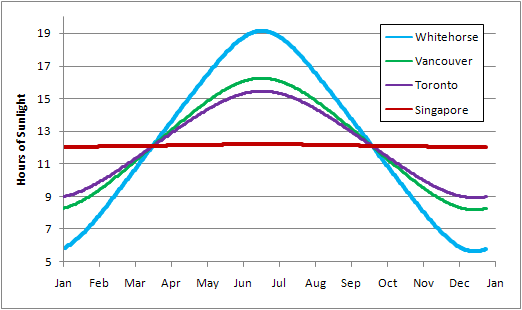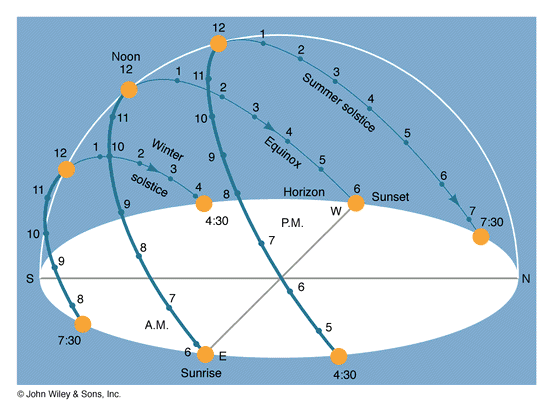When does the number of sunlight hours change the most?
When I began my rotation in Burrard Thermal in July 2010, I noticed that the sun’s glare would strike my monitor on days I stayed past 5 pm. Now we are in October, and my “glare time” is getting earlier and earlier, around 3:15 pm as of last week. So a question arose:
At what point in the year does the number of sunlight hours change the most?

A good starting point is looking at how sunlight hours vary throughout the year – via a sinusoid curve. During the vernal and autumnal equinox the number of sunlight hours is constant everywhere on Earth, approximately 12 hours. On the other hand, the summer and winter solstice yield a maximum and minimum number of sunlight hours for all places on Earth, with the deviation increasing away from 12 hours the further the location from the equator.
I selected several cities to show how the sunlight hours profile changes depending on cities latitude. Whitehorse is just south of the Arctic Circle and will have long summer days, and short winter days. Singapore is just north of the Equator and should not experience any large seasonal changes. Toronto / Vancouver are just places I have lived in my life.

On June 21st and December 21st the number of sunlight hours reaches a maximum and minimum of for all of the sample cities. At these points the daily change of sunlight hours is less than a second (which makes sense because the derivative at the maximum and minimum should be zero!). The steepest point on the sinusoidal curves is during the equinoxes in March and September. The day-to-day change in sunlight increases from approximately zero seconds to 3 minutes and 39 seconds for Vancouver in this time (again, this makes sense because the derivative reaches a maximum when 90 degrees shifted from the maximum and minimum).
Sun on the Run
Everyone has heard that the sun rises in the east and sets in the west, but this is only an approximation for most people on Earth. If you were to follow where the sun rises throughout the year you will see that it rises in the northeast horizon for half of the year, and southeast for the remainder. The reason is due to the Earth’s rotation, and the deviation from the eastern horizon increases with latitude. The diagram below shows how the sun’s path changes throughout the year for a city in the Northern Hemisphere. The reason I point this out is because if you were ever lost in the woods and needed a direction you might instinctively associate the east/west with where the sun rises/sets. Just remember the sun only rises in the east-ish horizon, and sets in the west-ish horizon!










Leave your response!